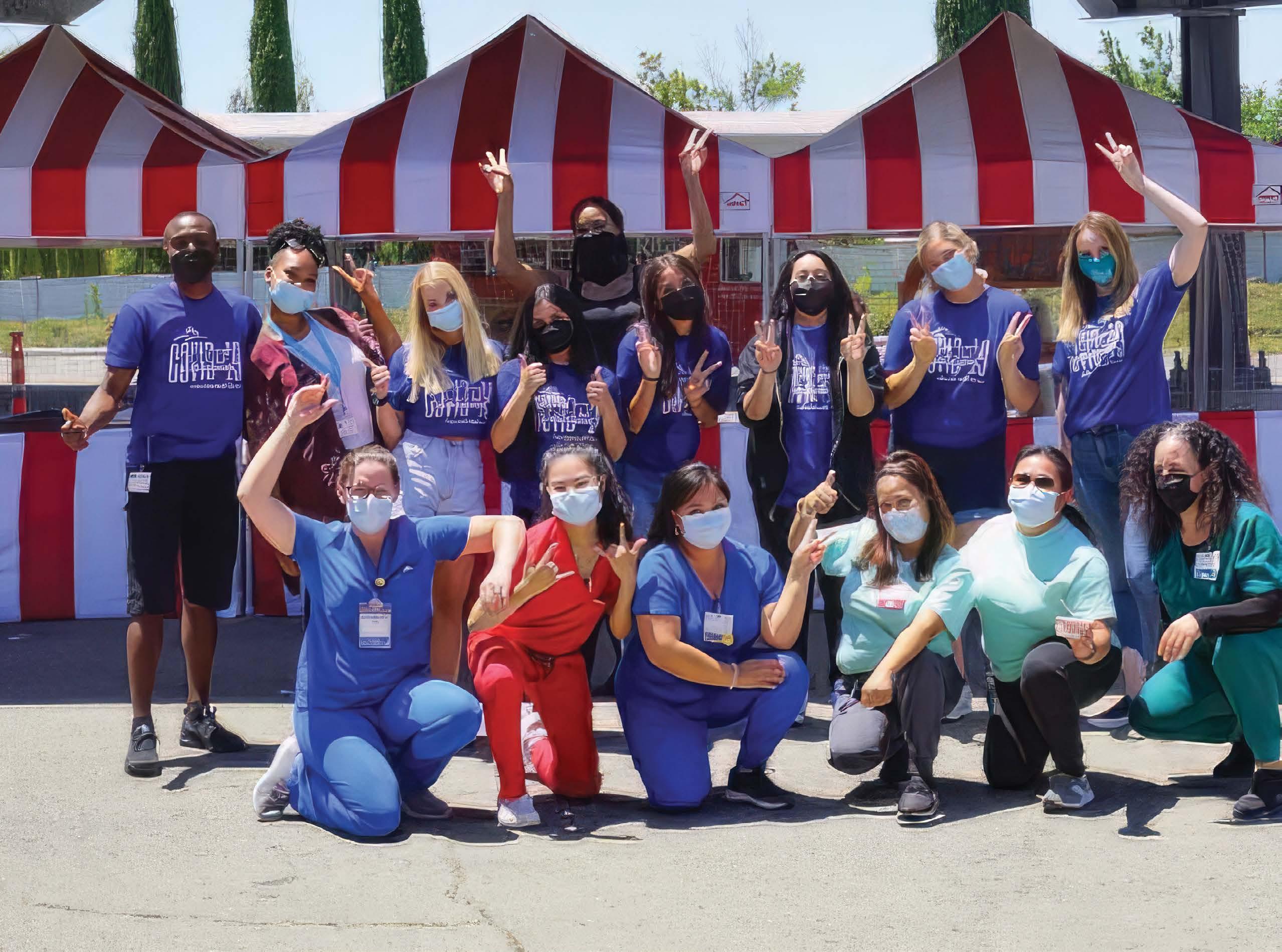2022 Annual Report

1220 Morello Ave, Suite 200 Martinez, CA 94553
cchealth.org





1220 Morello Ave, Suite 200 Martinez, CA 94553
cchealth.org



For those of us in the health field, 2022 was the year that saw a return to some level of normalcy—a chance to break out of the 24/7 COVID pandemic response and reinvigorate essential programs and relationships. Isolation was no longer the norm. We were back together, a little awkwardly at first, but able to sit in the same room and develop plans to forward Contra Costa Health’s mission of improving the health of the entire county, especially those communities and individuals too frequently left behind.

But normal in 2022 wasn’t quite what it looked like before the pandemic. We all carry painful memories of COVID—the lost friends and families, the suffering and the exhaustion of working around the clock.
But there were also important and positive lessons learned—lessons that fundamentally reorient the way we work today. We discovered how powerful we can be when we collaborate and integrate services. We were reminded of how much more impactful our messages are when carried by local, respected peers in each community. We saw the value of staying flexible and adopting new approaches, ideas and strategies. And, we were inspired by the communities—too long ignored and underserved—that stood up for equity in all things, including their health. Our challenge in the coming year is to fight the inclination to shrink back to old ways and instead integrate these valuable lessons in every program Contra Costa Health oversees.
In this annual report, we shine a light on just a few of the diverse Contra Costa Health programs that embraced the lessons of the pandemic in 2022 and delivered on the promise of our mission. From compassionate ways to deliver healthcare to the homeless to first-inthe-nation innovative programs aimed at serving people in the midst of a mental health crisis or addiction withdrawal, these examples only scratch the surface of the incredible work Contra Costa Health’s 4,600 employees and community partners deliver every day.
Whether we’re delivering healthy babies at our Medical Center, providing vaccinations at our clinics, offering healthcare through our county-owned health plan or working upstream to build healthier communities, everything we do at Contra Costa Health circles back around to building a county where everyone, regardless of their income, education, location or ethnicity, is living healthy, living safely and living well!
Anna M. Roth Chief Executive Officer, Contra Costa HealthAt the core of everything we do is delivering health, which means providing access to affordable, convenient and high-quality care, while removing the barriers to embracing healthier behaviors.

Provided health coverage to 21% of people in the county, including 1 in 3 children
Provided high-quality health care with:
• 450,000+ clinic visits
• 33,000+ emergency department & psychiatric emergency visits
• 8,000+ hospital admissions
• 3,000+ surgeries
• 1,800+ births
Provided $754 million+ in funding for community-based care & services through 214 contracts/agreements
Maintained one of the lowest COVID mortality rates in the nation with easy access to COVID care:

• 141,700+ tests

• 256,000+ vaccines & boosters
• 160+ mobile vaccine clinics

• 59,000+ home tests mailed
• 650,000+ home tests distributed in the community
• 3,200+ advice nurse calls for COVID treatment

• 460+ COVID hospitalized patients
Provided timely, transparent COVID information & data on the bilingual website, with 2.4 million+ views
Helped stop 313 COVID outbreaks at residential care facilities
Provided MPox education & 4,500+ vaccines
Out-of-hospital cardiac arrest survival rates above state & national averages
Provided care & support to 10,500+ people experiencing homelessness
Helped 780+ patients with opioid use disorder with medically assisted treatment
Distributed 1,220+ Narcan doses in the community
Safety is our most basic need, so we work with a host of programs, partners and government entities to build environments where people are safe from harm and can expect safe food, water and air.
Responded to 4 air quality & hazardous materials safety incidents
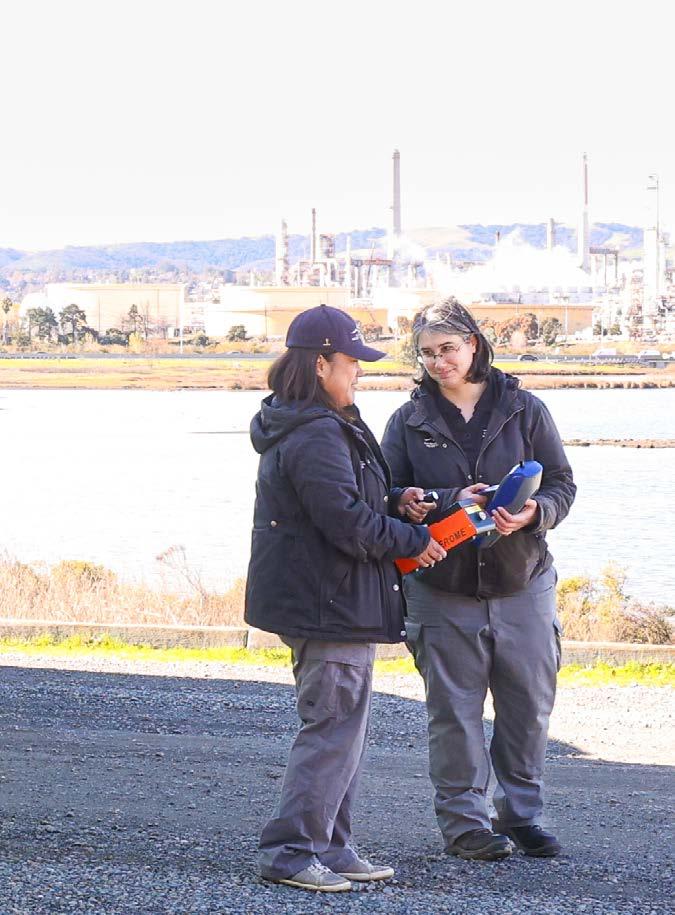
Certified 190 green businesses & saved:



• 2 million+ pounds in greenhouse gas emissions
• 2.6 million+ kilowatt hours in energy
• 5.8 million+ gallons of water
Inspected 6,000+ food facilities & helped correct 10,000+ food safety violations
Helped address 1,850 violations for hazardous materials & waste management
Removed 3,400 pounds of hazardous waste from public areas

Helped clean up drinking water for 12,000 people
Investigated & stopped 18 foodborne illness outbreaks


Inspected 1,600+ public pools & spas & helped resolve 10,500+ health & safety violations
Distributed 50,000+ masks to people impacted by the Pittsburg Marsh Fire
Awarded funding to establish a countywide gun violence prevention coalition
We work to address all the factors that foster well-being, including equity, education, employment, connections and personal growth.

Addressed the health & social needs of 8,000+ patients
Broke ground on 54-unit permanent supportive micro-housing project in San Pablo
Provided nutrition education & breastfeeding support to 19,000+ people
Delivered 864,700+ healthy meals to older adults
10.8% improvement in adolescent immunization rates overall, 11.1% among Latinx & 3.8% among Black people
Improved living conditions at 13 homeless encampments:
• Removed 675 tons of garbage
• Offered services to 300 people

• Connected 40 people to care & services

Quality Leader Award for Population Health from the California Association of Public Hospitals & Health Systems
2022 Community Health Quality Recognition from the Department of Health and Human Services
Rated highest in the National Committee for Quality Assurance annual report card, with high marks for patient experience and preventive care
Ranked in the top 90th percentile among all Medicaid HMOs in the country for six measures, including prenatal and postpartum care and cervical cancer screening
Named to the State of California’s Maternity Care Honor Roll
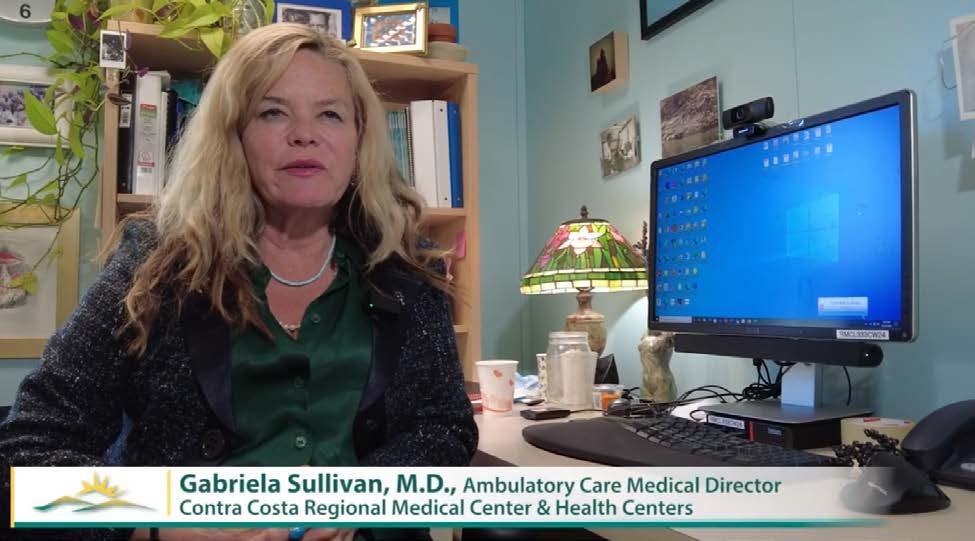
Helen Putnam Award for Excellence in Intergovernmental Collaboration for the A3 crisis response program from the League of California Cities
STAND! For Families Free of Violence Rollie Mullen Leadership Award
Contra Costa Deputy Public Health Officer Dr. Sara Levin received the Health Justice Award at the 2022 East Bay Philanthropy Awards
Visit
DELIVERING HEALTH FOR ALL COMPASSION, PATIENCE & UNDERSTANDING OPEN THE DOOR TO CARE FOR THE UNHOUSED
Building a relationship is the first step to helping the county’s most vulnerable
NAVIGATORS CONNECT PEOPLE WITH COMPLEX NEEDS TO CARE BEYOND THE DOCTOR’S OFFICE
Prioritizing prevention & whole-person care by addressing the health and social needs of patients
THE RIGHT CARE AT THE RIGHT TIME
A3 taps into a unique combination of lived experience & clinical expertise
NOVEL PROGRAM SMOOTHS PATH TO RECOVERY FOR OPIOID ADDICTION
Ambulance crews are stopping acute pain of withdrawals before people even arrive at the hospital
FOCUS ON HEALTH PROMPTS RESOLUTION OF SMELLY MESS IN CROCKETT
“I made a phone call, and the next thing I knew, we had resources coming in”
MENTORSHIP PROGRAM CREATES PATHWAYS FOR TOMORROW’S HEALTH PROFESSIONALS
High schoolers bring youth perspective, insights to health programs
YOUTH AMBASSADORS PUT UNIQUE SPIN ON HEALTH OUTREACH
“I saw how personal public health can be”
DOULAS & DADS RECRUITED TO IMPROVE BLACK INFANT HEALTH
Innovative CoCo Doulas program trains & lifts up Black workforce
QUICK DETECTIVE WORK & COOPERATION HALT
FOODBORNE ILLNESS
The pooling of unique skills moves investigations forward
EASY ACCESS TO COVID TESTS & TREATMENTS
No one should die from COVID when free testing, vaccines and effective medication are all readily available in our community
DELIVERING FREE COVID TEST KITS TO DOORSTEPS
Ensuring the community had the tools and information they needed to make healthy choices

With over a million people living in communities stretching from the Delta to the Bay, Contra Costa is a large, diverse and complex county. Serving the health needs and expectations of this burgeoning population demands a health department that is experienced, skilled, flexible and integrated. That’s what Contra Costa Health delivers.
Our bold mission of caring for and improving the health of all people in Contra Costa County, with special attention to the most vulnerable calls for a system of specialists who understand the many unique communities and neighborhoods we serve. It calls for the capacity to provide traditional medical care, while also working on policies and programs that create healthy and safe environments and support people in embracing healthier behaviors. It insists that we understand our county’s unique challenges, such as the large number of refineries that requires expertise in addressing hazardous materials.
Realizing this mission means that we treat not only physical ailments but also mental and behavioral health realities. It insists that we maintain a diverse, compassionate and dedicated staff with the lived experience that fosters the trust critical to successfully engage with our communities.
We lead the way in ensuring everyone in our county, regardless of income, has access to health care. And finally, to realize our mission, we have to stand up against the racism, prejudice and systemic discrimination that lock communities out of equitable health opportunities.
These capacities and a network of passionate community partnerships are what allow us to deliver on our mission. But it’s the integration of all of these resources and skills that allows us to do this efficiently. By braiding different expertise together and maximizing facilities for a variety of purposes, we amplify both our reach and effectiveness.
This also means Contra Costa Health repeatedly leads the nation with innovative, cutting-edge health programs that allow us to deliver both world-class health care and preventative programs for our county.
7 in 10 staff are people of color
Specialists ranging from mental health to hazardous materials
145+ community health navigators

Building a relationship is the first step to helping the county’s most vulnerable
Since middle school, voices in her head plagued Beth (pseudonym). Experiencing abuse as a child, the voices grew louder over the years, forcing Beth to isolate herself from family and communicate less and less. Regular wellness exams and care that most take for granted were out of reach for Beth and the people in the encampment where she lives; fear of judgment often the greatest barrier to that care.
Fortunately for Beth and others without stable housing, Contra Costa Health’s Health Care for the Homeless program bridges that gap and delivers essential medical and mental health care. Even more importantly for a population living on the fringe, this program delivers a level of compassion and understanding that has made the Health Care for the Homeless team welcome visitors to people experiencing homelessness.
“Homeless care is a long game,” says Heather Cedermaz, a family nurse practitioner and medical director of the program. “I think it’s about consistency, respect and building trust.”
Beth had been known to the team for years and lived on the streets during pregnancies with limited or no prenatal care. The voices and her mistrust of the medical establishment were barriers that made her pregnancies high risk, worrying the team. Because Beth did not make it to the hospital for all of her deliveries, every opportunity to build trust was essential for her health and that of her baby.
“She was very standoffish with our entire team and the first time I met her, she would not allow me near, almost running away to avoid an exam,” Heather explains. “Even without an exam, it was clear she was well into pregnancy and would deliver on the streets if we did not collaborate with city and county partners to bring her into care. This was my first encounter with her and I was concerned it meant we would never make the muchneeded connection for long-term health.”
Fortunately, working together with Contra Costa Health’s mobile crisis response team, the Health Care for the Homeless team helped get Beth admitted to a hospital where she safely delivered her child.
In the year following this delivery, Beth’s apprehension toward the Health Care for the Homeless team began to fade and her trust in Heather blossomed. As time went on, Beth continued to allow care intermittently.
“It’s humbling to be welcomed into their space,” Heather says. “They are in a vulnerable place when they invite us into their home, more so than we are going in. I think Beth gained something from each interaction with Health Care for the Homeless, but my bucket is definitely fuller than her bucket.”
Though still preoccupied with voices and distrustful of anyone outside of her peers, a bridge was being built, which allowed Heather and her team an opportunity to intervene earlier with Beth’s next pregnancy. Thanks to the relationship built during the previous year, Beth was receptive and allowed a test to confirm pregnancy as well as a clinical exam.
The Health Care for the Homeless team, working with Contra Costa Health’s Coordinated Outreach, Referral, Engagement (C.O.R.E.) program, behavioral health experts and the perinatal team discussed a plan to get Beth to the hospital to have her baby. But the night before the team hoped to get her to the hospital, Beth gave birth at the encampment. Friends called an ambulance to transport Beth and the child to a hospital, though Beth chose to leave alone within hours of arriving.
After the birth, Beth was hesitant to let Health Care for the Homeless team members talk to her at the encampment. However, when Heather, a recognized and trusted face arrived, Beth allowed for an examination. Though Beth was okay, Heather and the team acknowledged that if she were to become pregnant again, it could harm her health. Heather explained the concerns to Beth and told her there was safe, reversible medication to prevent pregnancy. Beth agreed to this immediately. Heather believed long-acting contraception could provide Beth more control over her body and hopefully decrease the added stress a pregnancy causes for many women experiencing homelessness.

Heather says the change in Beth since receiving the contraceptive was noticeable. “She’s been happier and even accepts hugs from me. It seems that the added control has improved her moods and opened the door for us to discuss and begin treatment for the voices.”
Though the arc of this story is years in the making, Heather feels that Beth’s story is that of countless women on the streets, each unique, but the same in so many ways.
“It’s about unconditional care and love,” Heather says. “We could all go there and judge, but that’s not our job. Our job is to reduce risk with a harm-reduction model. That’s the goal and purpose of our safety net institution. Beth is our mission. If we’re not taking care of her, who are we taking care of?”

Contra Costa Health prioritizes prevention and whole-person care by addressing the health and social needs of patients.

Contra Costa Health leads the county in ensuring access to care for those most in need. One-in-five people in the county is covered by Contra Costa Health Plan; almost all members are on Medi-Cal and 66% are people of color. The Health Plan offers a more equitable, coordinated and person-centered approach to maximize people’s health and life trajectory with the State’s transformation of the Medi-Cal system.
One such new benefit is connecting patients with complex needs who are facing difficult life and health circumstances directly with a community healthcare worker. These navigators coordinate care and health-related services for over 8,000 patients with the highest need, making it easier for them to get the right care at the right time. Community health workers also help people avoid unnecessary care, disease complications or costly emergency department visits by encouraging early detection of disease through health education about appropriate screening and promoting effective, timely management of chronic conditions.
The Health Plan coordinated equitable access to services that address physical, behavioral, developmental, dental, long-term care and social needs.
Read more about the drive to care for patients beyond hospitals and clinics in “Effect of Social Needs Case Management on Hospital Use
Among Adult Medicaid Beneficiaries: A Randomized Study” in the Annals of Internal Medicine online at bit.ly/3WPcbQB.

A3 taps into a unique combination of lived experience and clinical expertise
Unable to connect with mental health services, he had holed up for several days in an abandoned building and was self-treating his mental health issues with alcohol and fentanyl. Beyond being a nuisance to nearby businesses, neighbors were frightened and his mother reported that he had called threatening suicide. Things looked dire.
A year ago, the only solution would have been to dispatch local law enforcement, risking the possibility of elevating the man’s anxiety and placing him and police in an even more precarious situation. Fortunately, an innovative new program from Contra Costa Health called A3 (Anyone, Anywhere, Anytime) offered this man a better approach. Instead of sirens blaring, the man was met by a compassionate mental health clinician and mental health peer support worker trained to help de-escalate the situation and provide the support he needed.
“Sometimes, you just need someone to talk to who understands what you’re going through,” explains Dani Jimenez, the mental health peer support worker who was on the scene. “That could have been me a couple of years ago, so I know how much pain he was in. He’s scared. He probably hasn’t eaten or slept and he’s hurting. I know how valuable it is to have someone that can listen to you and really hear what you’re saying.”
While most calls to the A3 hotline are resolved over the phone, about one in four require an in-person response. By pairing a clinician with a trained peer who has lived mental health and addiction experiences, the A3 program offers a dramatically different way to help people in the field experiencing a mental health crisis. In this case, having a peer like Dani was especially important.
“I’m a mental health consumer myself and I just celebrated two years of being clean and sober from alcohol and drugs. Since I come from lived experience in these fields, I’m able to gain rapport with clients,” she says. “When we got there, he was pleasant with us. I knew someone who works at a detox center, so I reached out to find him a bed. Meanwhile, my partner (the clinician) was speaking with the man’s mom and working out a safety plan. We really connected when I shared my story about my own mental health challenges and recovery.”
“Wow!” he said. “And now you’re working for the county.”
“Many times, people have an arsenal of tools available to them, but in that moment, they can’t think straight. They need someone to help them slow down and assess what’s going on,” says Dr. Chad Pierce, director of the A3 program.
“Often, just talking through what happened and what the triggers are and asking what they think would be most helpful can give us the information we need.”
That’s what A3 offers. Created in partnership with local cities, law enforcement agencies and mental health advocates, the A3 program is a response to the tragic realities where people suffering from mental health episodes have been injured or killed by responding police. Introducing mental health experts at the front of these mental health crises, right when the emergency call is received, can be the difference between life and death.
Working with partner organizations across the county is crucial. Local police are notified when A3 teams are dispatched so they can provide support if needed, such as when a person may be a danger to themselves or others. A3 team members can also connect people to a wealth of resources available throughout the county, including mental health, housing, food and employment services. But sometimes, it’s about bringing a calming presence to recenter the situation.

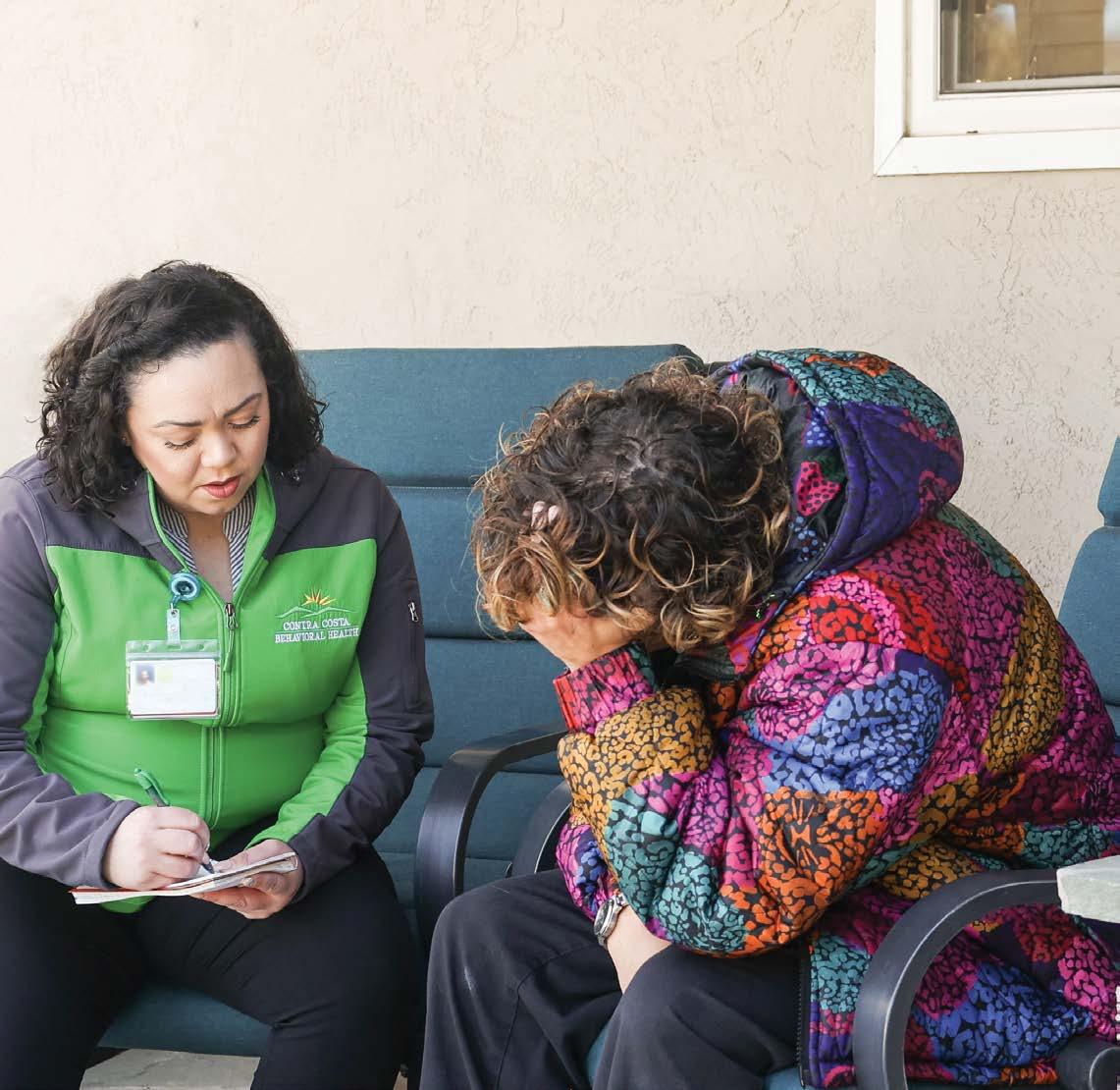
“So many times, they just need someone to listen. I feel remarkably lucky to be able to give them that support and to tell them that I’ve been there,” says Dani. “I was in the hospital a lot, so to be where I am now, it just gives me chills to be able to connect to our clients on that level and to support them in their recovery.”
75% of callers’ needs are resolved over the phone
1 in 4 people need an in-person response



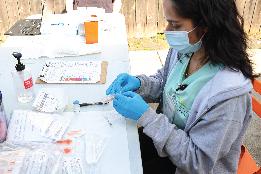
Ambulance crews are stopping acute pain of withdrawals before people even arrive at the hospital

The rescue drug Narcan is the end of one nightmare, but often the beginning of another. While the lifesaving medication immediately blocks the opioids that suppress the breathing of the person having an overdose, it also brings on severe withdrawal symptoms.
Fortunately, the medication buprenorphine can dull the intense cravings, headaches, anxiety, nausea and pain associated with withdrawal. However, in most of the country, people have to endure an excruciating ambulance ride and long wait in an emergency room before, and if, they can get that relief.
In Contra Costa County, that is no longer the case. Thanks to a pilot program launched by Contra Costa Health in 2020, Emergency Medical Services (EMS) can now administer buprenorphine in the field, offering immediate relief and setting people suffering from addiction on a smoother, more humane path to recovery. It’s all part of a comprehensive approach the Contra Costa Health has undertaken to fundamentally rethink how to structure care and treatment for people with addiction.
Paramedic Dubravka Frost remembers one person who was very aware that she was going through withdrawal and wanted to get to a hospital so she could get buprenorphine.
“I told her that I could actually help her there and then,” Dubravka said.
“The patient was very thankful and a little shocked that we could end her suffering right on the spot.”
Stabilized and receptive to further care, people begin their treatment journey. Most people who received buprenorphine are transported to Contra Costa Regional Medical Center, a designated opioid-receiving center equipped with trained, nonjudgmental staff and a culture that allows for a higher continuance of medication use.
Public Health Substance Use Navigator Tambra Divine is at the door when the patient arrives. In fact, every person in the county who was treated by EMS for opioid issues hears from Tambra. “I introduce myself and start building rapport right away. I let them know that we’re here to help, that our healthcare system offers them options.”
In the quiet privacy of a hospital room, Tambra takes her time guiding people through the next steps. She introduces the Choosing Change clinic, a comprehensive Contra Costa Health program that combines medication, group therapy and medical support for opioid use disorder treatment. Interested people are set up with an initial consultation and provided with the buprenorphine they need to see them through that appointment. After discharge, Tambra checks in regularly, following up at seven, 14 and 30 days.
Tambra handles each case with compassion, offering support both to people who are lifelong opioid users and those who unknowingly ingested opioids from contaminated substances. For Tambra, it comes down to helping families avoid the heartbreak she experienced when she lost her nephew to a fentanyl overdose.
“That’s what drives me every day,” she says. “That’s what fuels my passion.”
At Choosing Change, people move to a new phase of treatment. The program assesses people’s needs on a case-by-case basis, helping them set realistic goals. “We look at substance use, and specifically opioid use, as an ongoing disease process,” says Public Health Nurse Program Manager Phoebe Blaschak Olivera.
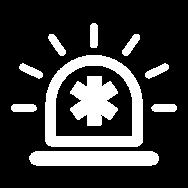
“For people with substance use disorder, stability ebbs and flows. That’s why long-term medication is essential.”
Professionals from all corners of the healthcare system come together to support program participants. Mental health providers oversee a series of medical group visits, fostering valuable conversations among patients. Doctors and nurses cut through pharmaceutical red tape to secure patients’ access to buprenorphine. An interdisciplinary team of community health workers handles all the headaches of scheduling appointments and interfacing with insurance companies.
Primed by a positive first interaction with EMS, people are more likely to take advantage of this wider system of care. Dubravka looks forward to updates on the people she provided with buprenorphine.
“We see these patients at their lowest, so we appreciate knowing they’re doing better,” she remarks. “It’s nice to know that we were the first ones to help them move in that direction.”
Contra Costa County is among the first in the nation to implement this first-responder EMS model for treating patients with opioid use disorder, serving as a successful model for similar interventions across the state and country.
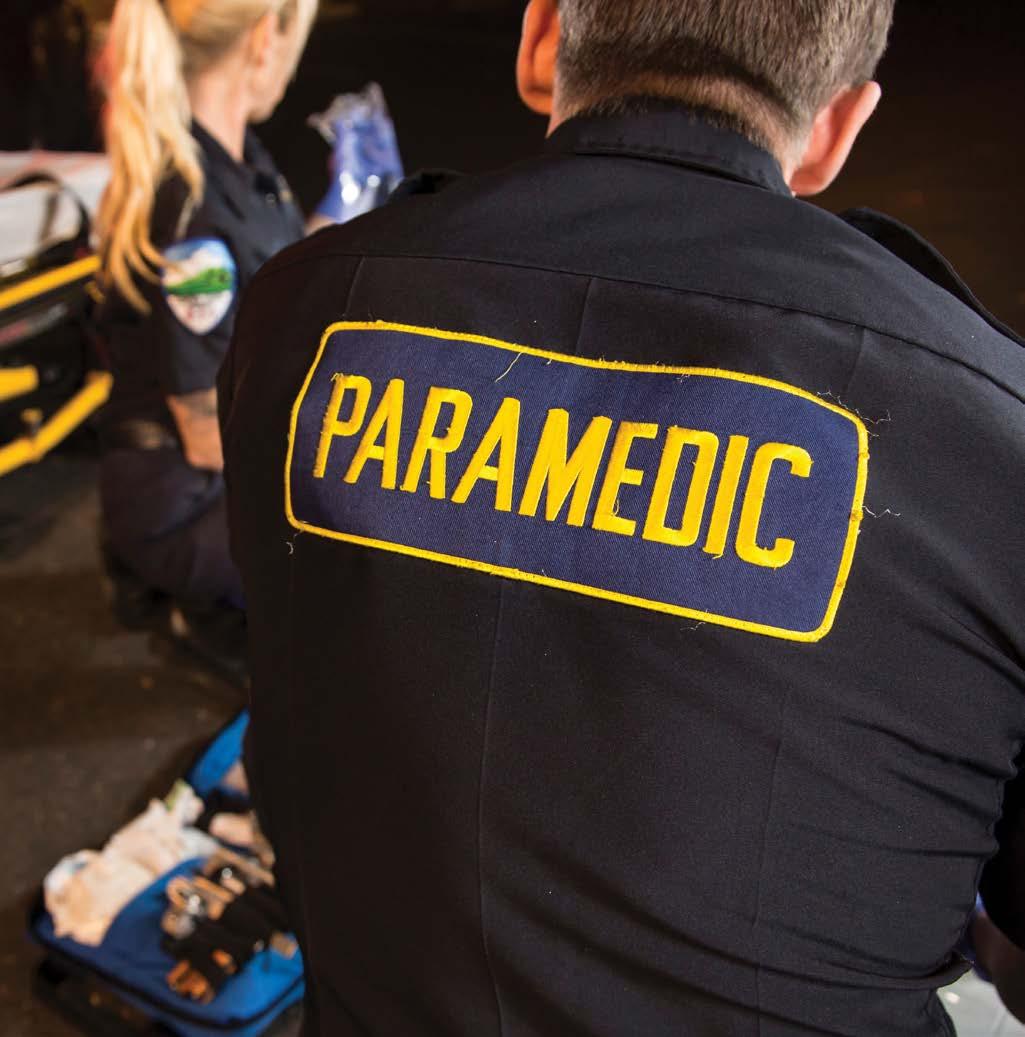
Thanks to the collaboration between Public Health, CCRMC and EMS, lives are being saved and needless suffering is reduced. According to Phoebe, “All these different programs come together so there is no break in the chain of treatment and recovery.”
160+ providers able to prescribe buprenorphine for Medication Assisted Treatment
780 people participated in Choosing Change
30% of people who received buprenorphine continued with medically assisted treatment for at least 30 days or more

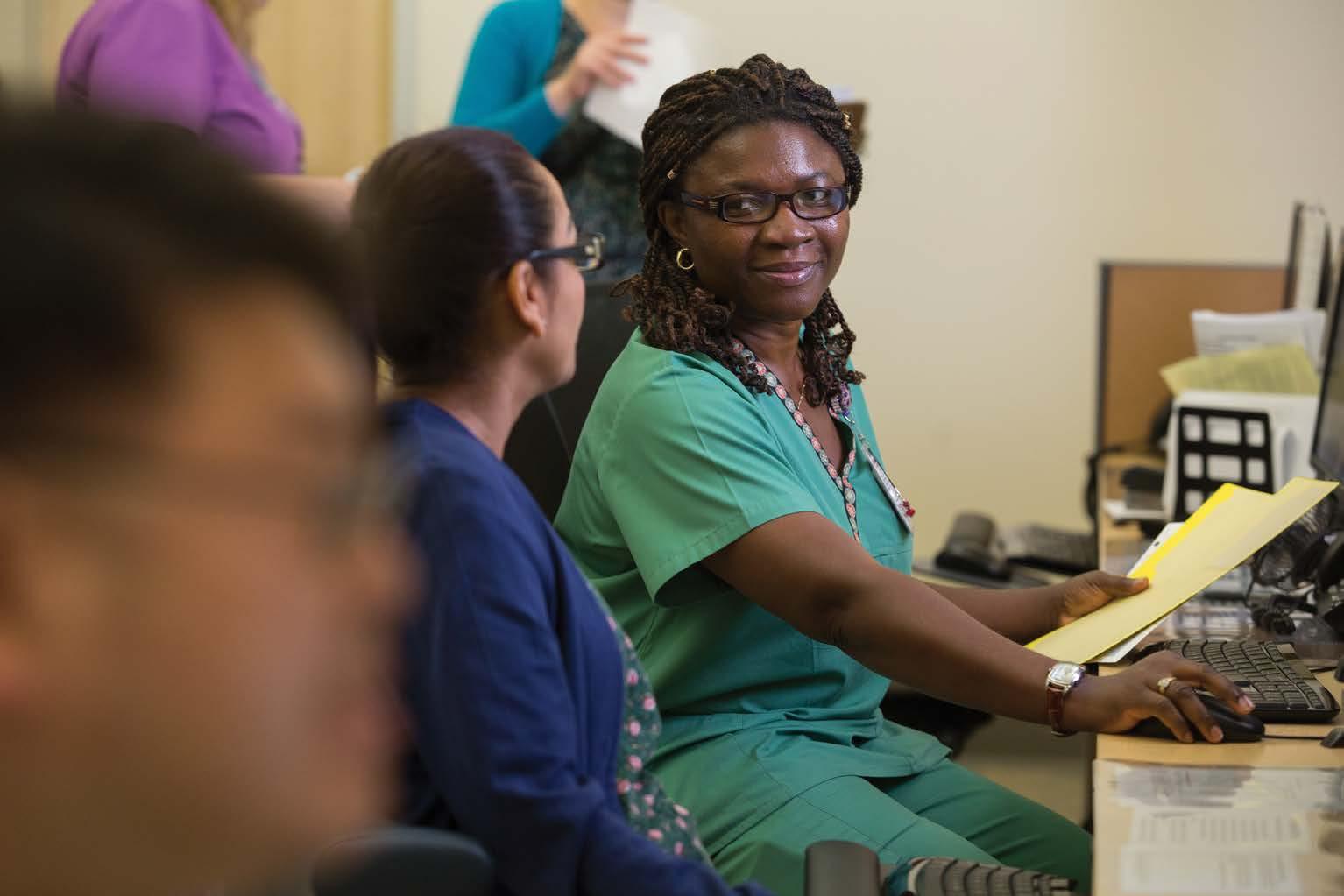


“I made a phone call, and the next thing I knew, we had resources coming in”
“The smell was horrific,” John Angell says, remembering a hot spell early last September when the odor of rotten eggs permeated the air in the town of Crockett. It wasn’t long before John, a Crockett resident and the security, attendance and safety coordinator at John Swett Unified School District, began receiving complaints from concerned parents, students and staff.
The stench came from the nearby Crockett Wastewater Treatment Plant, which processes sewage from both the C&H Sugar refinery and the Crockett community. Bacteria at the plant are supposed to consume waste and produce odorless carbon dioxide but a malfunction caused the bacteria to instead produce hydrogen sulfide gas, the source of the pungent scent blanketing the town.
John, along with other residents, contacted the Bay Area Air Quality Management District to learn when the issue would be resolved. Though the air district received hundreds of complaints and issued notices of violation to the treatment plant operators, the smell persisted for weeks. At the end of September, a power outage at the plant only caused the air quality to worsen. With no end in sight, John was determined to find out who was in charge of monitoring and resolving the situation.
On the evening of October 5, he called Contra Costa Health’s Hazardous Materials Program (HazMat). Though it was late, the person on the phone assured John that a HazMat team would be dispatched to Crockett to investigate.
By six o’clock the next morning, HazMat teams were at work at the middle school and high school in town. “They were fully engaged monitoring, testing and trying to figure out what was going on,” says John. “At one point, they were sitting with the students at the lunch tables, just chilling with the kids. It was cool to see that they were here on our campuses and they were dealing with it.”
Exposure to hydrogen sulfide can cause people to experience symptoms including headaches, nausea and burning eyes and can be a serious health issue at certain levels and lengths of time. Over the course of a week, the smell had gone from being a nuisance to a health concern. On October 7, hydrogen sulfide levels were high enough to be a minor health concern, causing Contra Costa Health to issue a health advisory.
John was amazed by how quickly Contra Costa Health responded to his initial call for help, but also by how they coordinated the key groups involved in the situation, including C&H Sugar, the air district and the Crockett Community Services District.
“I was blown away by the response,” shared John. “Contra Costa Health helped facilitate everyone involved. They didn’t need to do what they were doing. They did it because they cared and wanted to make sure that things were done right. It made me feel good that I made a phone call and the next thing you know, we had resources coming in.”
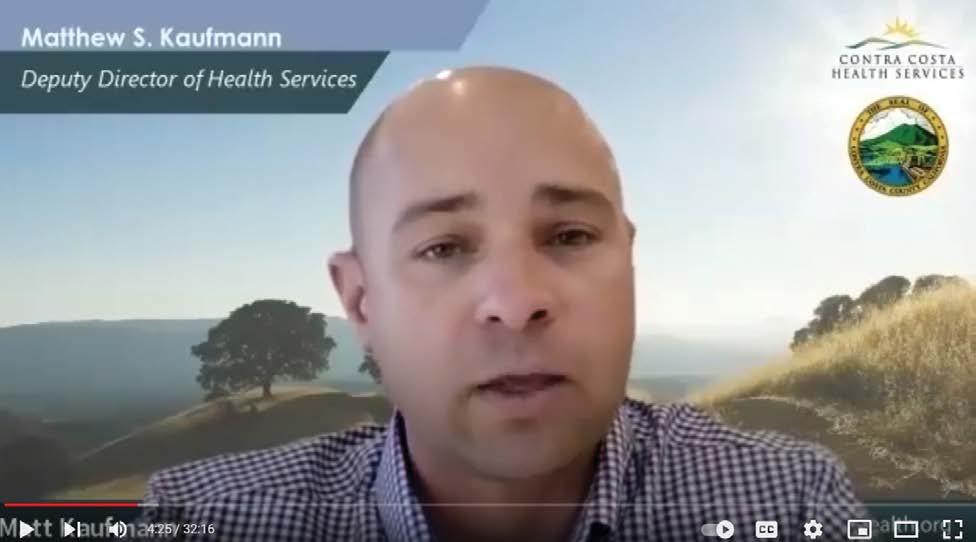
Contra Costa Health’s purpose throughout the incident was to highlight health impacts and to help keep the community safe. They initiated daily communication with local air and water regulators and coordinated daily meetings with the plant operator and the Crockett Community Services District to keep everyone apprised of the situation.
People were afraid of what this all meant for them. Some went to stay in hotels or left town completely. Families were concerned about whether or not they should send their children to school. Understanding these concerns, Contra Costa Health participated in community town hall meetings to listen to the community and inform them about what they could do to protect their health. They also issued a press release and held a media conference to answer questions. Local media took note and soon major outlets were reporting on the issue.
Keeping the schools open while keeping students and staff safe was a priority that both John and Contra Costa Health shared. Contra Costa Health worked with the Contra Costa County Office of Emergency Services to locate and deliver 43 high-volume air filtration units to the school district and Crockett Community Library. The heavy-duty purifiers used a carbon filtration system to remove the hydrogen sulfide.
John says students and staff noticed a significant improvement in indoor air quality once the air purifiers were in place. “There was a significant difference in the smell, it was almost like the air had been scrubbed.”
Thankfully, the issues at the plant were resolved and the smell dissipated. On October 17, after three days of reduced hydrogen sulfide levels, the health advisory was lifted. John expressed gratitude for the work Contra Costa Health did, “I am so thankful that the people who stepped in, stepped in. Had Contra Costa Health not gotten involved I don’t think it would’ve necessarily gotten stopped.”




The typical response when a young person expresses interest in healthcare is to encourage them to become a doctor or nurse, but the world of healthcare is far broader.
Contra Costa Health’s Health Career Pathways program is making a concerted effort to help high schoolers explore healthcare careers and learn about the depth and diversity of ways they can promote, improve and sustain health and wellness.

Contra Costa Health’s innovative Pathways program not only exposes aspiring healthcare professionals to the field but also helps them find pride in their lived experiences and invites them to design solutions to health disparities in their own communities.
More than 200 students from high schools across the county have participated in the program since its inception a decade ago. The program opens with a robust in-class curriculum covering topics such as “How -‘Isms’ Affect Health” and “What is Health Inequity.” Motivated students are encouraged to apply to participate in an eight-week paid internship that pairs them with a qualified mentor—either a Contra Costa Health employee or staff member from a participating communitybased organization partner. More than just shadowing a doctor or nurse, interns learn about the county’s prevention work through community-building activities, increasing language access, caring for the uninsured and organizing collective action to address social determinants of health.
“For me, this is all about giving students a step up and the ability to see how things work behind the scenes. I want them to see the big picture,” says Ernesto De La Torre, a Contra Costa Health program manager and mentor. “Students often think, ‘oh, I like the field’ but the internship helps them rule out certain things and discover different opportunities they probably never considered.”
The promise of the program is exemplified in Ernesto’s mentee, Annmarie Gutierrez. A 17-year-old student at Richmond’s De Anza High School, Annmarie has a passion for healthcare and a keen sense of equity. As part of the summer internship research project, Ernesto helped shape Annmarie’s upstream solution for preventing youth houselessness. Her idea was to train formerly homeless youth to facilitate school workshops about the issue and provide resources to youth in crisis to help break down stigma. Mentor guidance and feedback helped Annmarie keep sight of the real people at the heart of the macrolevel issue.
Ernesto went further, making a point of including Annmarie in his frequent COVID fieldwork across the county. Particularly impactful was one vaccination pop-up clinic at a food bank in Richmond, only minutes from Annmarie’s home.

“How had I never been there?” Annmarie remembered thinking. “This is a community that I felt that I was a part of, but I didn’t even know that these people were here and in need of help.” Newly activated, Annmarie arranged to extend her internship with Ernesto, who plans to incorporate her into various Health, Housing and Homelessness Services projects this year.
Initially unsure where she fit into the healthcare system, Annmarie wrapped up her internship with a clear focus on psychiatry and a deepened commitment to understanding the perspectives of marginalized communities. “I always wanted to take care of people, but now I have a new passion for achieving equity,” she reflects.
For his part, Ernesto says he is proud to be helping to build this high school pipeline that develops well-rounded healthcare professionals like Annmarie. “We need more people like her in the field.”
High schoolers bring youth perspective, insights to health programs

What chance do little digital red hearts have against a deadly, rapidly-spreading virus? As it turns out, quite a good chance.
At the height of the pandemic, with misinformation clouding every corner of the internet, health officials warned against turning to social media for COVID information. For young people suddenly pulled from school and isolated from their peers, the advice missed the mark. “Social media was one of the only ways we could stay in contact with each other in the early stages of the pandemic,” says Youth-Young Adult Ambassador Jasmine Turner of Rodeo. “That’s all we had and all we turned to.”
Contra Costa Health disseminated critical, scientificallybased information but struggled to effectively communicate to the county’s youth. This segment of the population wasn’t reading Contra Costa Health’s media alerts or checking the COVID data dashboards on the website; they were scrolling through Instagram and watching TikTok videos. It became clear that no one could better reach this audience than a member of that very audience.
And so Contra Costa Health’s Youth-Young Adult Ambassador Program was born. Equipped with vetted COVID information, 15- to 21-year-old ambassadors took to their social media feeds and launched a grassroots campaign to educate their peers. The familiar hashtag #cococrushincovid encompassed all matters of positive and educational posts. Critical public health messages were communicated from their personal profiles, reaching their high school classmates, sports teammates and childhood friends.
Never pedantic or paternal, the ambassadors became reliable and approachable resources in the community. In the three years since the program’s inception, over 60 ambassadors have stepped up to share essential health information.


As the pandemic evolved, so did the program. Messages extended to address MPox, food insecurity, racial injustice, heart disease, LGBTQ discrimination, the tobacco epidemic and more. Ambassadors started moving their advocacy offline, hosting art therapy activities, Black history events and holiday cookie socials for mental health. Concord native Harmony Castiglione remembers a carnival-themed vaccine clinic as a program highlight. The food trucks, fair games and gift card giveaways reflected the upbeat tone and positive energy that her social media posts had brought to her more than 20,000 followers earlier in the pandemic.
“I saw how personal public health can be,” says Jasmine. “It always seemed desensitized to me, kind of robotic. But this public health program was about figuring out who you are as a person, who you are as a community and meeting you where you’re at.”
Jasmine isn’t alone in this understanding. Many YouthYoung Adult Ambassadors have gone on to pursue health careers, bringing with them this commitment to centering community voices in health initiatives. These young leaders have shown their peers the variety of ways that Contra Costa Health can serve them and their families, and have likewise shown Contra Costa Health the vitality that Contra Costa County youth offer.
“I saw how personal public health can be”
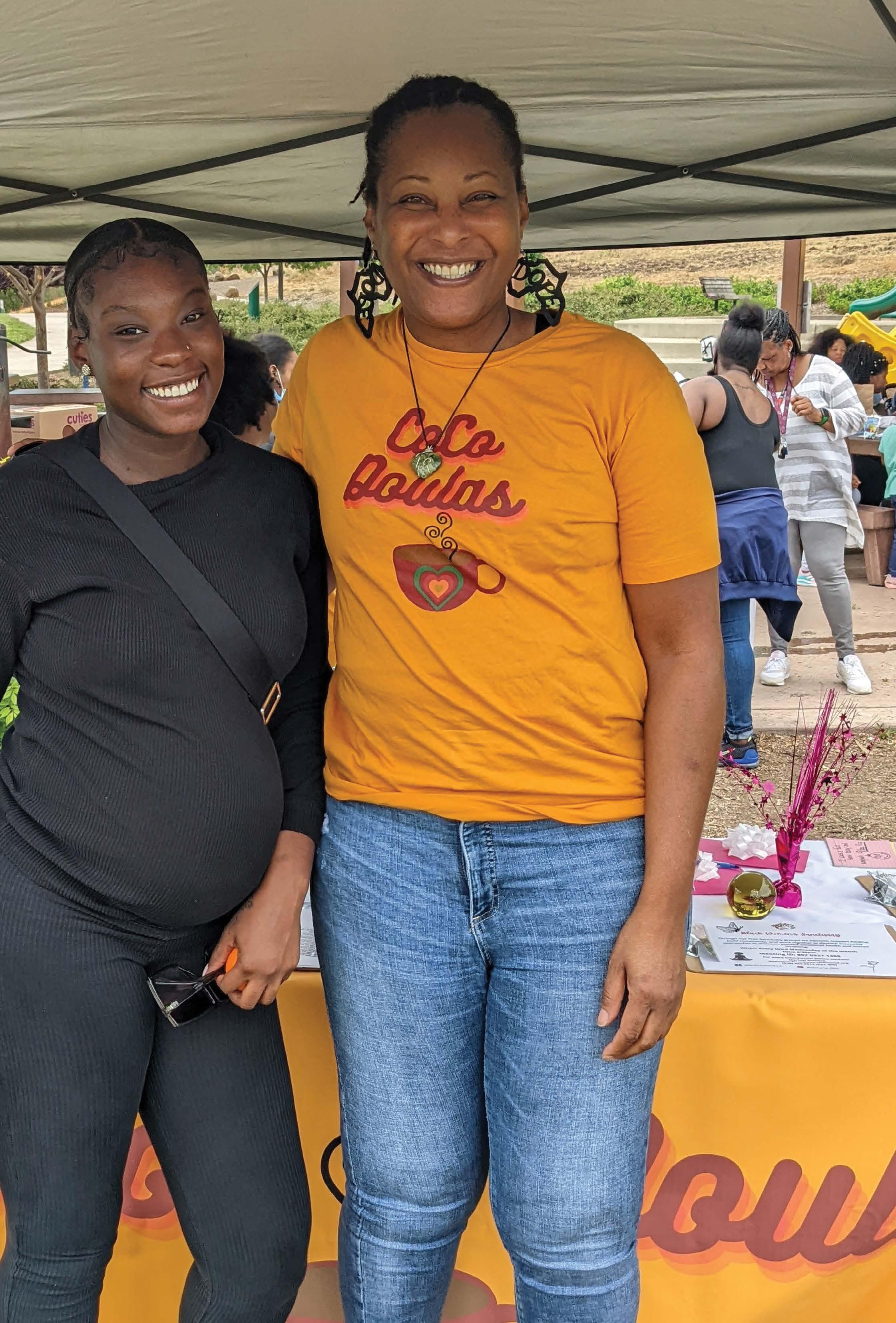
Setting up a nursery, choosing clothes, picking a name—these are the joyful landmarks for most expectant parents. But too many Black families face a far different and less uplifting reality.
Black babies in the Bay Area are two to three times more likely to be born too soon or too small or die before their first birthday. And Black mothers are three to four times more likely to have pregnancy complications such as hemorrhaging, cardiovascular complications and even death. What’s going on?
“These outcomes are preventable, and it’s not just by addressing an individual’s behaviors. It’s looking at the cumulative lived experience of Black people. Health inequities are impacting the whole Black family,” says Natalie Berbick, program director for Contra Costa Health’s Family, Maternal & Child Health program. She says these poor perinatal health outcomes are symptoms of structural racism and problems that have persisted for decades, including workplace discrimination, implicit bias in the medical field, lack of affordable housing and limited access to healthcare.
Determined to turn around these tragic trends and address the inequities that cause them, Contra Costa Health is investing in novel and tailored approaches. Through state funding for the Perinatal Equity Initiative, Contra Costa Health partnered with community-based organizations to launch two powerful pilot programs that build support and resiliency for Black families.
Doulas are trained professionals who provide emotional, physical and educational support to people throughout their pregnancy, birth and the postpartum period. Contra Costa Health partnered with Building Blocks for Kids, a Richmond community-based organization, to create a fellowship program called CoCo Doulas that trains, supports and uplifts the Black doula workforce in Contra Costa County.
Lauren McCollins coordinates the program and says that before it started it was difficult to find Black doulas in Contra Costa, “Now we’re coming together, we’re knowing each other. It’s beautiful that we can both serve and connect.”
Passionate about maternal well-being and improving disparities in the Black community, Savaneh Martinez is a West County mother of five who is now a doula thanks to CoCo Doulas. “It’s an honor to be able to prepare, encourage and empower women to enter their sacred birth space as they see fit. Doulas play an integral part in bringing forth a positive experience for mothers, even if things are diverted from the original plan. We help mothers feel well-informed about their decisions and help them be aware of their rights.”
Savaneh says that each stage of the CoCo Doula training helped her feel prepared to serve. “I went from not knowing how attainable being a doula was to now being a doula, a maternal mental
health peer support specialist, a lactation peer support specialist and I just obtained my lactation educator certification, with more to come. But it all began with CoCo Doulas.”
Krishonda is an Antioch mother who participated in the program. She says that her doula, Jillian, gave her much-needed support and she still keeps in contact with her today because of the significant role she played in her pregnancy. “Before I was referred, I didn’t have that support that women should have when they’re pregnant. Once I met Jillian, it just turned around for me. I was looking forward to meeting her every week and talking to her. Some people have a job and that’s all it is. But I can tell she is passionate about what she’s doing.”

In partnership with Aspiranet, a Pittsburg community-based organization, Contra Costa Health’s Partners in Pregnancy Fatherhood Program is also working to strengthen Black families. Facilitated by Fatherhood Engagement Specialist Lonnie Blanson, the program offers a 12-session course for fathers expecting a child or parenting an infant with a Black mother. Primarily run in group settings, the Fatherhood Program has become a protected safe space for fathers to openly discuss and reflect upon everything from their own experience being parented, stressors in their lives, strategies for how to support their child’s mother and how they want to be as a parent of a Black child.
Unlike many similar programs, the majority of fathers who start the program finish it. And Lonnie says that the growth these participants go through is clear to see. “After completing the program, they’re more knowledgeable about how they can support their partner and they have a better idea of the type of father they want to be, and how they can become that person.”
Lonnie explains that many fathers may not know just how much racism and discrimination impacts the mother of their child. The program helps them understand these challenges and makes them want to become more involved with their partner and their child. “They start going to doctors appointments together and they know what types of questions they should ask and what discussions they should have so they can become the best possible parents for their child,” explains Lonnie.
Michael is a first-time father who participated in the program. He says that the program helped him on his fatherhood journey. “As a first-time father who didn’t have a father growing up, it was really good for me to hear the experiences not only of other men who already had children but also others who grew up with their father and some of the things they learned and applied. I was appreciative of that and I think it’s helped make me a better first-time father.”


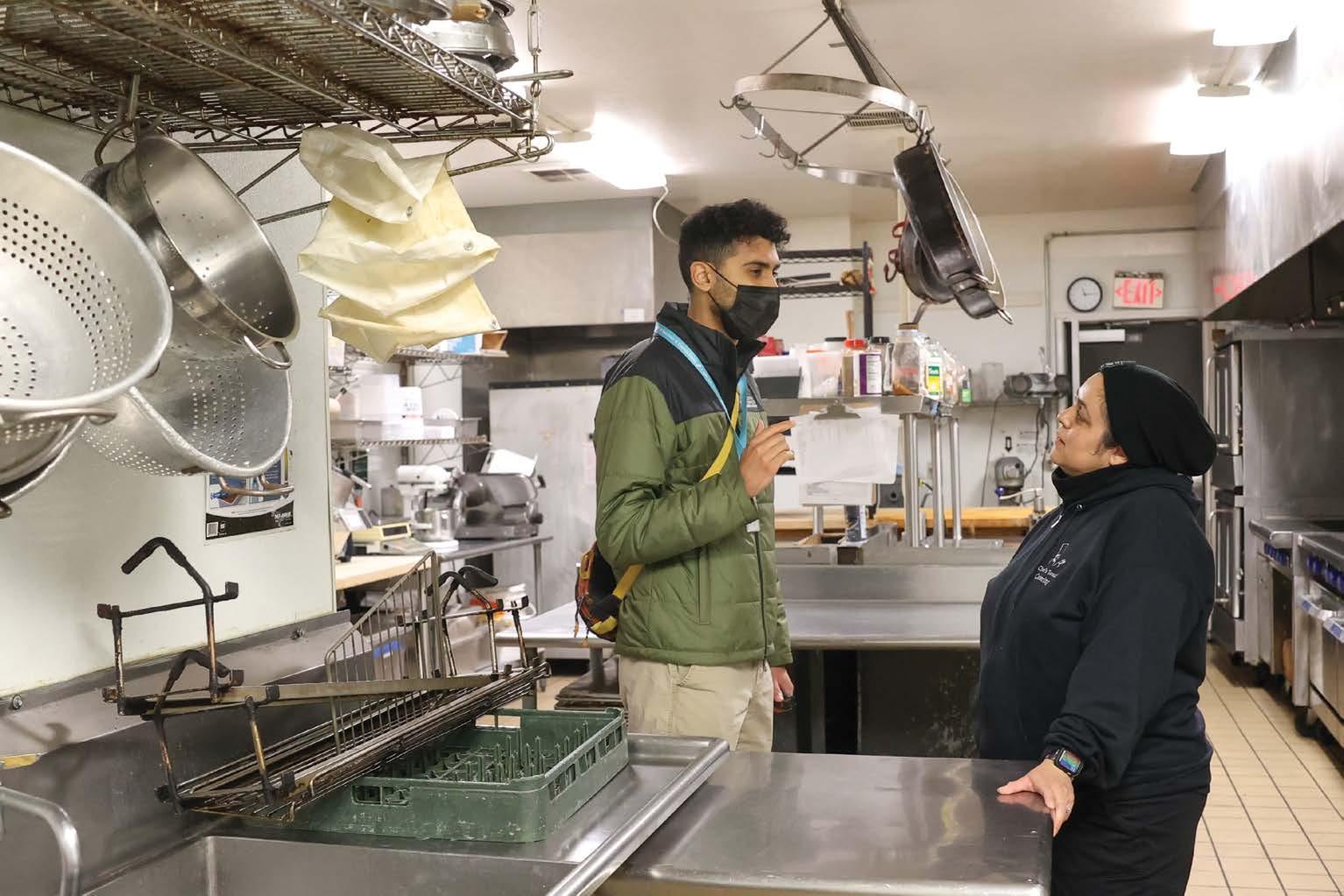

The pooling of unique skills moves investigations forward
The clock is ticking. The stakes are high. No one has any clue what happened—except that 14 people are ill. How did a lighthearted lunch celebration result in a foodborne illness outbreak? In what looks like a detective whodunit, the Contra Costa Environmental Health team dives into yet another foodborne illness investigation.
Environmental Health is no stranger to investigative work, but this case presented a unique challenge. This wasn’t a routine restaurant inspection or health violation follow up. Foodborne illness outbreaks involve any number of factors and require immediate action. To make matters worse, concrete facts about the luncheon were few and far between. “At the start, we had no information,” remembers Supervising Environmental Health Specialist Michele DiMaggio. “We didn’t know what they ate. We didn’t know the symptomology. We didn’t have the infected people’s contact information.”
The obvious starting place was the burritos, all 1,200 of them. The Environmental Health Outbreak Response team—a team of specialists on call 24/7 year-round—wasted no time inspecting the scene of the crime. The burritos were reported suspiciously sour at the first lunch serving, so the dinner meals were consequently disposed of. A sigh of relief—the source was identified and the outbreak was
controlled. Unfortunately, the partygoers had been too thorough in controlling the outbreak, throwing away all potential food samples. Led by Michele, the team found a few burritos stashed away in the recesses of a fridge— a break in the case. Samples were immediately sent to the California Department of Public Health laboratory for testing.
Next, the Environmental Health team turned to the food operator in question. After all, the outbreak at the celebration might have been controlled, but restaurant patrons could still be at risk. They learned that the restaurant was located in neighboring Alameda County, making this case cross-jurisdictional and inherently more complex. Michele looped in Alameda Environmental Health, dispatching Retail Food Supervisor Jackie Greenwood and her team to conduct multiple rounds of interviews at the restaurant. Nervous employees made for a complicated investigation, requiring persistent follow-up and no small amount of tact. “It wasn’t until the second visit that the interviews actually brought out information that we could work with,” said Jackie.
Simultaneously, the Contra Costa Environmental Health team worked to piece together a hypothesis. Contaminated meat seemed like the evident culprit, but interviews with those infected revealed that both the vegetarian and meat burritos had been contaminated.
This clue brought the rice and beans under investigation. Sure enough, the State laboratory soon reported that the food samples tested positive for the bacteria Clostridium perfringens, one of the most common causes of foodborne illness. Jackie’s team filled in the rest of the details, reporting that massive quantities of rice and beans were prepared the day before the celebration and left out at room temperature overnight. In short, the perfect storm.
With an eye on the big picture, the two teams dug deeper to understand how a mistake like this could have occurred. The small restaurant, they learned, was largely unequipped to handle a catering order of that magnitude. Fortunately, the restaurant closed to the public to focus on the order. Unfortunately, they brought in additional people who were not employees to help prepare the food, and who very likely had never received proper food preparation training. In Jackie’s words, “Just about everything that could go wrong did go wrong.” Her team followed up with the restaurant to temporarily halt operations while they administered comprehensive food handling training.

“With this fast-paced, high-stakes work, you just can’t afford to work in silos,” says Contra Costa Environmental Health Assistant Director Kristian Lucas. “Collaboration is key.” Relationships cultivated over many years allowed Contra Costa Environmental Health, Contra Costa Public Health Acute Communicable Disease, Contra Costa Public Health Laboratory, Alameda Environmental Health and the California Department of Public Health Food Emergency Response Team (FERT) to solve this case.
In the end, the outbreak was controlled and the investigation was concluded before the month’s end. Working as separate entities to meet a common goal, the various groups were able to get ahead of the outbreak and prevent more people from getting sick. The key to this rapid response? An integrated health system approach centered on communication and collaboration.
“Other systems might have been bogged down by the number of hands involved, but Contra Costa Health thrives on cooperation,” says Kristian. “The pooling of unique skills moved the investigation forward.”


“No one should die from COVID when free testing, vaccines and effective medication are all readily available in our community. Preventable COVID deaths in our county are unacceptable,” said Contra Costa Health Director Anna Roth.

The beginning of 2022 saw a dramatic surge in COVID spread, with a huge amount of people home sick from work and school, the highest levels of hospitalization at any point in the pandemic and a tragic number of people succumbing to the disease. As COVID cases waned in the spring, Contra Costa Health refocused the county’s emergency response to the pandemic on eliminating preventable deaths.
“There are stark differences in COVID mortality rates between our wealthiest, healthiest neighborhoods and those with significant challenges to community health,” said Gilbert Salinas, CCH chief equity officer. “This effort helps us to sharpen our focus on our most vulnerable communities.”
CCH increased access to and the use of home tests and oral antiviral treatments for COVID, particularly in communities where infection and death rates are highest.
One groundbreaking approach was opening the Contra Costa Health Plan advice nurse phone line to any county resident who tests positive for COVID, scheduling free telehealth appointments and prescriptions for treatment when medically appropriate. CCH urged other medical providers in the county to ensure that all people who test positive for COVID have timely access to medicine if appropriate for the patient’s health background.

With another potential wintertime COVID surge looming over the 2022 holiday season, Contra Costa Health wanted to ensure the community had the tools and information they needed to make healthy choices.
A mail-order home test kit program was launched, inviting people to request free test kits by phone or online, and received over 900 orders in the first four hours. Staff worked quickly to ship tests, delivering more than 59,000 tests to people’s doorsteps between November and January, and distributed over 650,000 free test kits to medical facilities, skilled nursing facilities, community-based organizations, county libraries and offices of elected officials.

The community was encouraged to stock up on home test kits, to test if they felt sick before gathering with others and to stay home if they tested positive. “We want these test kits to be a staple in people’s medicine cabinets like aspirin or band-aids,” said Dr. Sofe’ Mekuria, deputy health officer for the county. “Testing gives people the information they need to make healthy choices and reduce the spread of COVID, especially during the winter holiday season when families and friends gather indoors.”
Increased testing helped reduce the spread of the virus, with COVID rates at the end of 2022 not nearly as high compared to the previous year.
